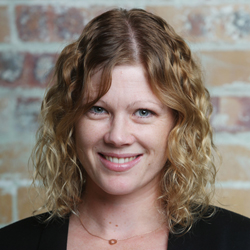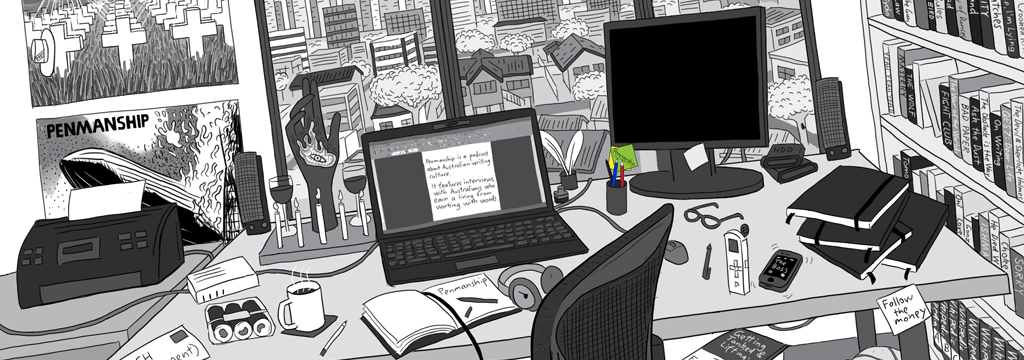Kate Kyriacou is an author and chief crime reporter at The Courier-Mail.
 By coincidence, I met with Kate at News Queensland’s offices in Bowen Hills on August 3, the day that her first book was published. It’s called The Sting: The Undercover Operation That Caught Daniel Morcombe’s Killer, and it’s a true-crime narrative about a case well-known to every Queenslander, and most Australians, I’d wager, given the high-profile nature of the disappearance of 13 year-old Daniel Morcombe in December 2003. Besides writing and publishing The Sting, Kate is chief crime reporter at Queensland newspaper The Courier-Mail, where she has worked since 2012, following earlier stints reporting in Mildura, Melbourne and Adelaide.
By coincidence, I met with Kate at News Queensland’s offices in Bowen Hills on August 3, the day that her first book was published. It’s called The Sting: The Undercover Operation That Caught Daniel Morcombe’s Killer, and it’s a true-crime narrative about a case well-known to every Queenslander, and most Australians, I’d wager, given the high-profile nature of the disappearance of 13 year-old Daniel Morcombe in December 2003. Besides writing and publishing The Sting, Kate is chief crime reporter at Queensland newspaper The Courier-Mail, where she has worked since 2012, following earlier stints reporting in Mildura, Melbourne and Adelaide.
Crime reporting is a tough beat: day in, day out, these reporters are dealing with some of the nastiest aspects of human nature. Being immersed in this world can take an emotional toll, which is something that Kate and I discuss in this episode. We also explore the tension of writing a whole book about one of these nasty characters; her experiences as a junior reporter in a regional city and having daily briefing with the local police over tea and breakfast; Kate’s early interest in children’s literature and young adult novels, which remains an area she’d like to explore in her own writing; why she prefers colour reporting over straight news writing, and the traits required for crime reporters to succeed in this taxing business.
Kate Kyriacou has been a journalist since 2001. She has written for newspapers around the country, including the Sunday Herald Sun, the Adelaide Advertiser and Sunday Mail, and Brisbane’s Courier-Mail and Sunday Mail. She has been The Courier-Mail’s chief crime reporter since 2012 and has won awards, at both a state and national level, for her work as a crime writer. Her first book is The Sting: The Undercover Operation That Caught Daniel Morcombe’s Killer, published by Echo Publishing in August 2015.
Kate Kyriacou on Twitter: @KateKyriacou
Direct download | iTunes | Stitcher | Libsyn | YouTube
Timeline:
2.00 The publication of Kate’s first book, The Sting, and the differences she is finding between representing a newspaper and herself
4.00 How Kate first began reporting on the Daniel Morcombe murder case, and began working on the book after the trial
5.30 The frustrating elements of the Morcombe case, including how police were knocking on Brett Cowan’s door two weeks after his disappearance
7.00 Brett Cowan’s criminal past and the jail sentences he served after being found guilty of sexually abusing young boys
8.00 Kate’s deadline for the book was around April or May 2015; she wrote it in around six months
9.30 How Kate went out about outlining a chapter-by-chapter structure for the book
12.00 “No one told me how to write a book, or what they were expecting – they just said ‘go for it’”
14.00 How Kate dealt with the emotional impact of immersive herself in reporting such a dark crime case
18.00 “If something upsets me or I find something difficult, I always feel like I’ve got no right to feel like that; it’s not me who’s suffering through this”
18.30 Kate’s relationship with Bruce and Denise Morcombe, Daniel’s parents, who were “very wary” of giving any publicity to the man who killed their son
21.00 How Kate reported on the covert aspects of the police operation against Brett Cowan, including ‘Joe Emery’ befriending Brett on a flight from Brisbane to Perth
26.00 The ‘Mr. Big’ police scenario that captured Brett Cowan, which was developed in Canada and has been used for over 100 years there
32.00 A couple of scenes from this aspect of the Cowan operation were published in The Courier-Mail and The Sunday Mail in early August
35.30 How Kate went about structuring the narrative of The Sting, beginning with a scene from the covert operation
40.00 How Kate navigated the tension between wanting to tell the story of how they caught Brett Cowan and not wanting to give publicity to him
43.00 The pieces of the puzzle that Kate couldn’t find while writing The Sting, like not being able to speak to the Western Australian covert officers
45.00 How Kate handles situations where police media advisers sit in on interviews and attempt to control what is asked and answered
47.00 How Kate handles situations where sources ask to check quotes or her writing: “it’s fraught with danger”
48.30 The common misunderstanding that journalists write the headlines and choose the imagery that accompanies a newspaper story
49.30 How Kate handles the tension between objectivity in her reporting and ‘advocacy journalism’ in what she wants the reader to think
51.00 Kate grew up in a beachside suburb of Adelaide, attended a public high school and had a teacher who laughed when she said she wanted to be a journalist
52.00 Kate studied professional writing at the University of South Australia and was “a very laidback student”, graduating in 2000
54.00 At age 21, Kate applied for the first job she saw, which was at a regional newspaper in Mildura, Victoria
55.00 Kate’s older brother accompanied her on the move to Mildura; he told her editor that she was “a champion beer-sculler – which was embarrassing, although true”
57.00 Kate had a briefing meeting with the local police sergeants at the station every morning, over a cup of tea and breakfast
59.00 The first few court stories that Kate wrote, she asked a police detective to proofread them for her to make sure she didn’t make any errors
60.00 Kate’s writing interests while growing up include children’s literature and young adult novels, like John Marsden, Roald Dahl and Isobelle Carmody
61.00 “I can’t even remember why I wanted to be a journalist. I think it’s more that I wanted to be a writer”
63.00 Kate remembers reporting on one particularly horrific incident at a party in Mildura, while she was working at The Sunday Herald Sun
64.00 How Kate writes crime stories: she mostly writes descriptive ‘colour’ pieces instead of straight news stories
65.00 To illustrate, Kate gives the example of writing about Eunji Ban, a young girl who was murdered while walking through the city in November 2013
66.00 “That was really about putting the reader into her mind as she was walking home that night: what it was like, the things that she would have seen”
68.30 How Kate goes about cultivating sources: people who will either talk to her on the record or on background
71.00 Why Kate believes that people talk to journalists, including in ‘death knock’ situations: “You have to give them a reason to speak to you”
74.00 What stands out in Kate’s mind after 15 years of reporting on the less appealing aspects of human nature: “Always the people that I’ve met”
81.30 The traits required for crime reporters to succeed in this business: “You’ve got to be tough, and you’ve got to be able to talk to everyone”
84.00 What Kate wishes more people understood about her job as a crime reporter: “To do a story justice, you have to involve your emotions a little bit”
85.00 How Kate decompresses outside of work: “My best outlet is my sport”, including surf boat rowing at Maroochydore

